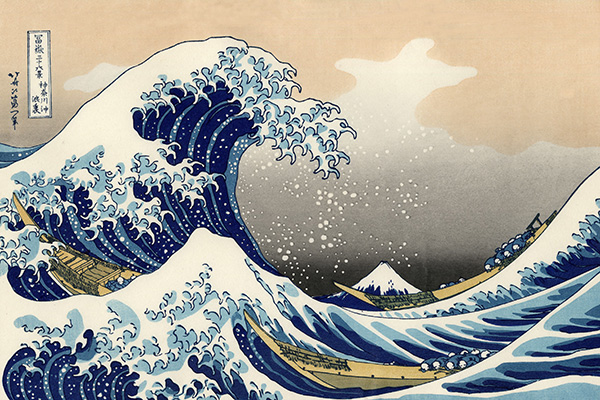Ukiyo-e, The Floating World
The Great Wave off Kanagawa in particular is a forceful statement about the power of nature, and was most recently used in the context of the tsunami that tragically hit Japan in 2011. There are rip-offs everywhere: in one particularly amusing example, artistic duo Kozyndan sneakily turns the white tips of the waves into rabbits. Consequently, it was somewhat surprising to come across this very print framed in a collection in the Dunedin Public Art Gallery (DPAG).
Ukiyo-e, The Floating World forms part of the DPAG’s “collection” of exhibitions entitled The Pleasure Principle, which covers the entire downstairs floor. Lining the walls of the largest room are woodblock prints gifted to the gallery by various donors, such as Dr Hocken and the family behind Olveston (that old house on the hill), who collected them in Japan during the immediate aftermath of World War II. Because prints were easier to transport than paintings the Gallery has a generous collection. This exhibition is therefore an artistic experience that could consume hours of your time.
The exhibition devotes itself to explaining who donated each work rather than the context and concepts surrounding them, which is a little unfortunate. Ukiyo-e refers to a specific genre of woodblock print made in Japan between the 17th and 20th centuries that depicts landscapes and comment on aspects of Japanese life. “Ukiyo” is literally translated as “floating world,” referring to an atmosphere separate from mundane reality. The examples of such prints in the DPAG’s exhibition are satisfyingly disconcerting: neither completely mythical nor completely realistic.
Dominating an entire wall is (most of) Hokusai’s Thirty-six Views of Mount Fuji. Each individual print features Mt Fuji, either as the brooding main subject or as a subtle background to a more dynamic focal scene. Although incomplete, this collection is absorbing. Hokusai was innovative in his exaggerated and yet realistic depiction of nature – particularly wind and water. He creates a strong, clear atmosphere in each print that leaves viewers with a sense of isolation. The faces of his figures – often labouring in rural landscapes – are rarely depicted, and this lends his works a slightly haunting feeling. The contortion and flattening of space contributes to the unsettling effect.
Literal and highly intricate, the Japanese woodblock print has a potently distinctive style. However, this particular exhibition includes a wide variety of works that successfully showcase the range of individual styles within the genre. In comparison to those of Hokusai, Andō Hiroshige’s works are subtle and somehow more poetic – a less literal depiction of Japanese culture. His Asakusa-gawa-shubi-no-matsu imraya, which portrays a night scene, is one of the most stunning in this collection. The viewer is utterly immersed in the still darkness of night, yet all that is shown is a light blue sea tinged with navy blue and a deep sky scattered with stars.
Presenting some of the finest examples of Japanese woodblock prints, this exhibition is well worth seeing – especially if you don’t consider yourself a fan of this particular style of art.



